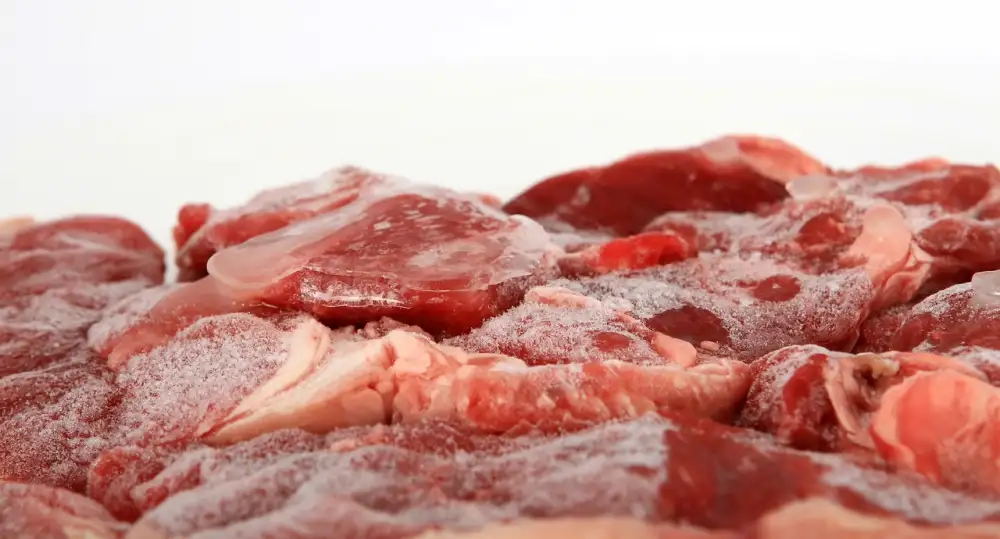Mastering the Art of Brisket Beef: A Tender Delight for Meat Lovers

- Understanding the Cut: Lower Chest of Beef
- The Versatility of Brisket Beef in Cooking
- Selecting the Perfect Brisket Beef
- Preparing Brisket Beef for Cooking
- Slow Cooking Techniques for Tender and Flavorful Brisket Beef
- Popular Recipes and Cooking Methods for Brisket Beef
- Tips and Tricks for Achieving the Best Results with Brisket Beef
- Serving and Pairing Suggestions for Brisket Beef
Brisket beef, a cut that comes from the lower chest of the cow, is a true delight for meat lovers. Known for its rich flavor and tender texture, brisket beef offers endless possibilities in the kitchen. Whether you're grilling, smoking, or slow-cooking it, this versatile cut never fails to impress. In this article, we will explore the art of mastering brisket beef and discover how it can elevate your culinary adventures to new heights. So get ready to embark on a journey of flavors and indulge in the deliciousness of brisket beef!
Understanding the Cut: Lower Chest of Beef
When it comes to mastering the art of brisket beef, it is essential to understand the cut of meat you are working with. Brisket beef comes from the lower chest area of the cow, which is known for its rich and flavorful meat. This particular cut consists of two parts - the flat and the point.
The flat, also known as the lean portion, is a thick and rectangular muscle that is relatively lean compared to other cuts. It requires slow cooking methods to break down its tough fibers and render it tender and juicy. On the other hand, the point is a fattier and more marbled section that adds incredible flavor to your dishes.
Both parts of the brisket beef have their unique qualities, making them versatile in various cooking techniques. From smoking and braising to roasting or even grilling, this cut can handle it all. The key lies in understanding how each part behaves during cooking and adapting your methods accordingly.
By familiarizing yourself with the lower chest cut of beef, you will gain a deeper appreciation for its tenderness and flavor potential. So next time you're at your local butcher or grocery store, don't hesitate to ask for brisket beef and explore its culinary possibilities.
The Versatility of Brisket Beef in Cooking
The versatility of brisket beef makes it a favorite among chefs and home cooks alike. This cut can be prepared in various ways, allowing for a wide range of flavors and textures. Whether you prefer slow cooking, smoking, or braising, brisket beef can handle it all. Its rich marbling and connective tissue break down during the cooking process, resulting in tender and succulent meat. From classic barbecue to hearty stews and even gourmet sandwiches, the possibilities are endless with brisket beef. Get creative in the kitchen and explore the many ways you can showcase this flavorful cut in your culinary creations.
Selecting the Perfect Brisket Beef
When it comes to selecting the perfect brisket beef, there are a few key factors to consider. First and foremost, look for a well-marbled piece of meat. The marbling, or fat content, is what adds flavor and tenderness to the brisket. Look for even distribution of fat throughout the meat.
Next, pay attention to the color of the meat. It should be a deep red color, indicating freshness. Avoid any cuts that have a grayish tint or appear discolored.
The size of the brisket is also important. A larger cut will take longer to cook and may require more effort to maintain its tenderness. On the other hand, a smaller cut may dry out during cooking. Aim for a brisket that weighs around 8-12 pounds for optimal results.
Lastly, consider the grade of beef. Prime grade is the highest quality and will yield the most flavorful and tender brisket. Choice grade is also good, while select grade may be leaner but less juicy.
By carefully selecting your brisket beef based on these criteria, you can ensure that you are starting with a high-quality cut that will result in a delicious and satisfying meal.
Preparing Brisket Beef for Cooking
Before you embark on your culinary journey with brisket beef, it is crucial to prepare the meat properly. Start by trimming any excess fat from the surface of the brisket. This will prevent the meat from becoming greasy during cooking.
Next, marinate the brisket to enhance its flavor and tenderness. You can use a variety of marinades such as soy sauce, Worcestershire sauce, garlic, and spices. Allow the brisket to marinate for at least 4 hours or overnight in the refrigerator.
To further tenderize the meat, consider using a dry rub. A combination of salt, pepper, paprika, and other herbs and spices can add depth of flavor to your brisket. Massage the dry rub into the meat, ensuring it is evenly coated.
For optimal results, let the seasoned brisket sit at room temperature for about 30 minutes before cooking. This will allow the flavors to penetrate into the meat.
By taking these simple steps in preparing your brisket beef, you are setting yourself up for a delicious and tender dining experience that will leave your taste buds craving more.
Slow Cooking Techniques for Tender and Flavorful Brisket Beef
Slow cooking is the key to achieving tender and flavorful brisket beef. This method allows the tough connective tissues in the meat to break down slowly, resulting in a melt-in-your-mouth texture. There are several slow cooking techniques that can be used to achieve this desired outcome.
One popular technique is braising, which involves searing the brisket beef on high heat to develop a rich crust, then simmering it in liquid at a low temperature for an extended period of time. This method not only tenderizes the meat but also infuses it with flavor from the braising liquid.
Another technique is smoking, which involves cooking the brisket beef over indirect heat for several hours. This slow and steady process imparts a smoky flavor into the meat while keeping it moist and tender.
Alternatively, you can use a slow cooker or crockpot to cook your brisket beef. This convenient method allows you to set it and forget it, as the meat slowly cooks over several hours. The result is incredibly tender and juicy brisket beef.
No matter which slow cooking technique you choose, it's important to be patient and allow enough time for the meat to cook thoroughly. This will ensure that the connective tissues have enough time to break down, resulting in a tender and flavorful brisket beef that will impress even the most discerning meat lovers.
So embrace these slow cooking techniques and unlock the full potential of your brisket beef. Your taste buds will thank you!
Popular Recipes and Cooking Methods for Brisket Beef
1. Classic Texas-Style Smoked Brisket: Rub the brisket with a blend of salt, pepper, and spices. Smoke it low and slow over hardwood for several hours until tender and smoky.
2. Braised Brisket with Red Wine: Sear the brisket on all sides, then braise it in a mixture of red wine, beef broth, onions, and herbs. Cook it in the oven until the meat is fork-tender.
3. Asian-Inspired Soy-Glazed Brisket: Marinate the brisket in a mixture of soy sauce, ginger, garlic, and brown sugar. Slow cook it in the oven or a slow cooker until it's meltingly tender.
4. Barbecue Brisket Sandwiches: Slow cook the brisket with your favorite barbecue sauce until it's fall-apart tender. Shred the meat and serve it on buns with coleslaw for a delicious sandwich.
5. Mexican-Style Brisket Tacos: Season the brisket with chili powder, cumin, and other Mexican spices. Braise it with tomatoes, onions, and peppers until it's fork-tender. Serve it in tortillas with salsa and avocado.
These recipes showcase the versatility of brisket beef and highlight its ability to absorb flavors while becoming incredibly tender through slow cooking methods. Experiment with these recipes or create your own to discover new ways to enjoy this delectable cut of meat.
Tips and Tricks for Achieving the Best Results with Brisket Beef
To achieve the best results with brisket beef, here are some tips and tricks to keep in mind. Firstly, choose a well-marbled cut of brisket for maximum tenderness and flavor. Secondly, make sure to properly season the meat with a dry rub or marinade to enhance its taste. Thirdly, allow the brisket to come to room temperature before cooking to ensure even cooking throughout. Fourthly, when slow cooking, maintain a low and steady temperature to break down the tough fibers and render the fat. Lastly, let the cooked brisket rest for at least 15 minutes before slicing to retain its juiciness. By following these tips, you'll be able to savor a perfectly cooked and delicious brisket beef dish every time.
Serving and Pairing Suggestions for Brisket Beef
When it comes to serving and pairing brisket beef, the options are endless. One classic way to enjoy this tender delight is by slicing it thinly and serving it on a bed of creamy mashed potatoes. The richness of the beef pairs perfectly with the smoothness of the potatoes. For a burst of freshness, you can also serve it with a side of tangy coleslaw or pickles. Another popular option is to make sandwiches with the leftover brisket beef. Simply pile it high on a soft bun and top it with your favorite barbecue sauce or horseradish mayo for an extra kick. If you're feeling adventurous, you can even use the brisket beef as a filling for tacos or enchiladas, adding some Mexican flair to your meal. Don't forget to pair your brisket beef dish with a full-bodied red wine like Cabernet Sauvignon or Malbec to enhance its flavors. Whether you choose traditional sides or get creative with international flavors, serving and pairing brisket beef will surely elevate your culinary experience.
In conclusion, the richness and versatility of brisket beef make it a must-have ingredient in any meat lover's culinary repertoire. Whether you prefer slow-cooked, tender slices or succulent, melt-in-your-mouth barbecue, brisket beef offers endless possibilities for creating delicious and satisfying meals. So, don't hesitate to explore the world of brisket beef and let your taste buds embark on a flavorful journey. Embrace this tender delight and elevate your cooking to new heights with the art of mastering brisket beef.
Published: 20. 11. 2023
Category: Food



